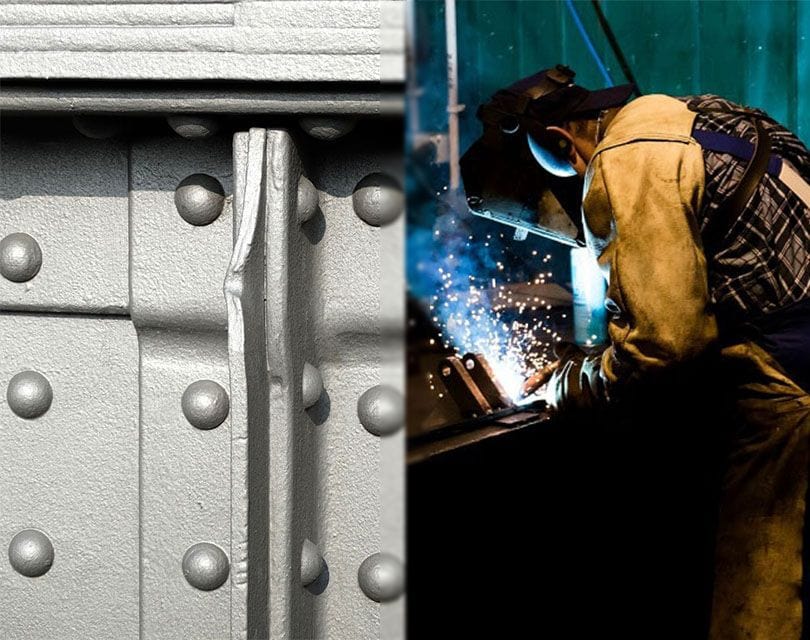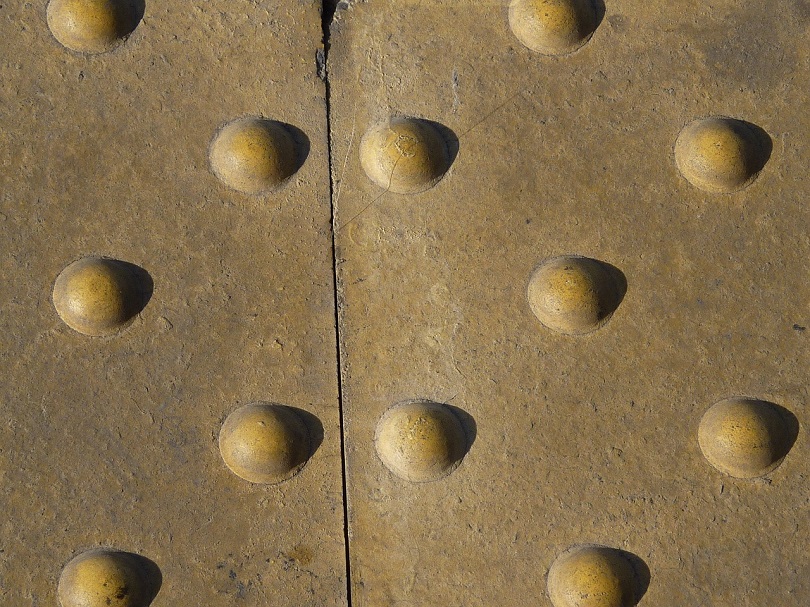Riveting vs Welding: What Are the Pros & Cons of Each Method?
Last Updated on

Choosing the right metal joining method is very important as it makes your product structurally and commercially sound. There are several factors that one should look out for when choosing the appropriate joining process. Join us as we take a comprehensive look at the pros and cons of riveting versus welding.
An Overview of Riveting

Riveting is a permanent metal fastening process using a metal part called rivet. This rivet binds to the adjacent surfaces of the elements. So, the basic concept behind riveting is similar to that of nuts and bolts, but instead of two separate pieces, a rivet is just a single piece with both of its ends holding each piece of metal.
How Does it Work?
A rivet has two ends known as head and tail. The tail is usually a smooth cylindrical shaft, while the head is a hemispherical dome.
To install, this rivet is positioned in a punched or drilled hole. The tail of this rivet is deformed such that it expands approximately to about 1.5 times its original shaft broadness. A new head is formed on the tail’s side by smashing its material to become flat, making it look like a dumbbell. This holds the rivet in its position and unites the metal parts together. The deformed head is called the shop head for distinguishing between these heads, while the original charge is known as the factory head.
As there is a head-on on each side of the installed rivet, this joint can bear considerable shear and tension loads.
Common Types of Rivets
Solid
Most solid rivets are made out of aluminum because it can easily be bucked from the tail using a pneumatic hammer. Therefore, a solid rivet needs to have cold forming property without cracking in between the procedures. The countersunk head angle could vary from 60° to 120°. However, 82° to 100° are commonly used angles. Sometimes, the sharp ends of some solid rivets are removed while still maintaining the flush fit.
Blind
They are named blind rivets because they can be fully installed from just one side. Only a single operator with less training can install a blind rivet; the tool used for installing it is also portable. These rivets have an advantage over solid rivets where just one side of the workpiece is accessible. With a given length, the rivet can be used with many materials of varying thickness. This rivet is very easy to install, and even the clamping force is better and uniform than a solid rivet.
Pull Mandrel
These are installed with a tool that imposes a force on the rivet head while pulling a serrated mandrel through for expanding the other side of the tubular rivet. When the appropriate load is reached, this mandrel breaks at the notch.
Threaded Stem
Threaded stem rivets involve a stem with the outside part flattened by a machine on two sides for the tool to hold and rotate. The head is usually hexagonal so that no rotation takes place.
Tubular
These are partially hollow and are available in various configurations. The hollow end of this rivet is made to undergo cold forming to a field head. As highly extensive cold forming is required with these kinds of rivets. Therefore, these are ductile and made of low strength materials.
Applications
Riveting has been very widely used for a long time. Famous structures like the Eiffel Tower and the Sydney Harbour Bridge are held together by riveting. Armored tanks, airplanes, gutter construction, hanger straps, and automobile chassis also involve riveting. It has to be done even to support your common jeans, doors, and windows.
- Rivets are cheap compared to welding equipment
- Riveting can be done regardless of the position/location. (vertical, etc.)
- Very high shear strength and resistance from fatigue
- Removing a rivet causes less damage than a welded joint
- Some rivets can tolerate atmospheric and chemical corrosion
- No considerable damage to the protective coatings of the parts involved
- Can be used to join ferrous, non-ferrous metals, and even non-metals
- Need to pre-drill holes
- Noisy process
- Time-consuming
- Not a leakproof joint
- Rivets add weight while the holes reduce stability
- Riveted joints are significantly bulkier than welded joints
- Not always aesthetically appealing
An Overview of Welding

An alternative to riveting is this permanent fabrication procedure known as welding. This joining process takes advantage of thermo-softening of materials (softening on heating and hardening on cooling). It is usually used to connect metals and thermoplastics. It uses high heat using electricity to melt the pieces and fuses them to cool and solidify.
How Does It Work?
Firstly, the base metal is melted using high heat. After that, a filler material is added to this joint to create a molten material called the weld pool. This weld pool cools down and forms the joint; based on its configuration, this joint can be stronger than the base or parent metal. The pool is pressurized to produce a tight and solid welded joint. This process also requires some protection or shield so that the filler and melted materials do not contaminate with environmental factors.
Common Types of Welding
Arc Welding
This kind of welding includes many manuals, semi-automatic and automatic welding processes. The techniques contained are usually used to join stainless steel, aluminum, cobalt, titanium, nickel, and copper alloys. And this type of welding is used in the oil, gas, power, aerospace, and automotive industries.
- Metal Inert Gas Welding (MIG)
- Stick Welding
- Tungsten Inert Gas Welding (TIG), also commonly known as gas welding
- Metal Active Gas welding (MAG)
- Flux Cored Arc Welding (FCAW)
- Gas Metal Arc Welding (GMAW)
- Submerged Arc Welding (SAW)
- Shielded Metal Arc Welding (SMAW)
- Plasma Arc Welding
Friction Welding
This technique is based on mechanical friction. It can be applied over different materials like steel, aluminum, and even wood too. Mechanical friction is used to generate heat to soften the base material, mix, and create a solid bond as it cools. No flux, filler, or shielding gas is required in friction welding.
This process is beneficial for aerospace application as it can unite the ‘non-weldable’ lightweight aluminum alloys.
- Friction Stir Welding (FSW)
- Friction Stir Spot Welding (FSSW)
- Linear Friction Welding (LFW)
- Rotatory Friction Welding (RFW)
Electric Beam Welding
This is the welding process that uses a high-velocity beam of electrons to produce heat and melt the workpieces to bind them together. It is performed in a vacuum to avoid the dissipation of the beam of electrons. This welding type is mainly used to unite thick metal sections.
Laser Welding
Here, a laser is used to concentrate high heat, ideal for deep, barrow welds, and high joining rates.
This method takes substantially less time than other methods, making it suitable for high-volume applications in the automotive industry. It can be performed in the air and does not require a vacuum.
Resistance Welding
This process is speedy, and hence, used in the automotive industry. It can be broken down into two categories:
- Spot Resistance Welding: The spot welding process used heat produced between two electrodes applied to a small portion to clamp the workpieces.
- Seam Resistance Welding: This is very similar to spot welding, just the electrodes are replaced with rotating wheels to end with a uniform leak-free weld.
Applications
Different types of welding are used for various purposes, like shipbuilding, industrial piping, railroads, manufacturing plants, automotive, home improvement, aircraft, aerospace construction, and mechanical industries.
- Welded structures are lighter than riveted joints
- More efficient than riveting
- Alterations or modifications are relatively easy in comparison
- Better aesthetics
- Skilled labor with supervision is required
- Uneven heating and cooling can result in distortion, which may result in extra stress
- Cracks may develop
- Must pass tougher inspection criteria
Other Factors to Consider
Now that we’ve covered the basics of both processes, let’s look at factors to consider that will determine which is right for the task at hand.
1. Materials to be joined
Are the metals you want to join the same or different? If different, then what are the differences, and to what extent they affect their joining?
Advantage: Riveting is more versatile when it comes to joining different materials.
2. Stress bearing capacity
How much compression or tension can the metal withstand?
Advantage: Both are supremely strong joints but welding takes a slight advantage.
3. Changeability
Do you want a permanent joint or temporary joint? If you need to reposition it, then how many times can you change it so that the joint does not collapse?
Advantage: Welding
4. Melting and boiling points
Advantage: None
5. Response to environmental conditions like rain, dust, oil, etc.
Advantage: Welding
6. Appearance after joining
Should the joint be exposed or hidden? Do you prefer minimalistic and seamless aesthetics or rough and bold?
Advantage: Personal preference
7. Manufacturing cost and time
The budget and timeframe to meet for joining the metals
Advantage: Subject to variable conditions
8. Preservation and servicing expenses
The cost of maintenance and repair of the joints. How often will the joined components require repairs or maintenance checks, or replacements?
Advantage: Welding
Riveting vs Welding: Which is Better?
Safety
So, which one is safer as safety should always be the priority. A properly welded joint is stronger than a riveted joint if we consider the forces that can draw pieces apart. Therefore, welding should be preferred for bond strength. Although welding is definitely not safe for unskilled labor or poor supervision, it may lead to severe injuries.
Specific Applications
This should be the first question that you should answer, as this is crucial in your final decision.
- For temporary joints that require replacement or repositioning, mechanical fastening or riveting is preferred over fusing or welding.
- Riveting and welding are stronger joints than adhesive joints, and the better of the two is already discussed earlier.
Cost
In general, riveting is costlier than welding, although rivets are cheap. But due to the bulk calculations involved in its installation, it has costlier labor. However, the cost factor highly depends on which welding type you are considering and similarly for riveting which rivets you are referring to. Some types of welding need very high skilled workers, which definitely adds to the cost. Hence, this is variable and subjective.
Convenience
Welding is absolutely convenient because no holes or excessive calculations are needed like those required for riveting.
Time
As time is money and very precious. This aspect should not be ignored. As heating processes take time, hot riveting takes time as it does not use the welding heat methods. Comparatively, welding takes low time as drilling holes, inserting the rivets, heating the protruded end, and then bucking them; this procedure definitely requires a substantial amount of time. However, riveting involving cold forming takes less time.
Final Thoughts
Riveting and welding are of great importance in many industries around the world. Both have offered great strength and have helped greatly in creating the structure or frame of modern innovations. They are both part of the methods widely used to create a joint between two or more metal surfaces. The choice of which one to use is dependent on what a worker intends to achieve. To answer the question, “Riveting vs Welding: What Are the Pros & Cons of Each Method,” welding comes first when one considers efficiency, durability, and strength, especially when working on lighter structures. Riveting, on the other hand, is essential in manufacturing industries. Heavy-duty equipment and heavy metals are mostly joined by riveting. Therefore, it becomes essential for one to choose wisely when planning to undertake any work that involves joining metallic products.
You may also be interested in: Can You Weld in the Rain? The Surprising Answer!
Featured image credit: Pixabay
